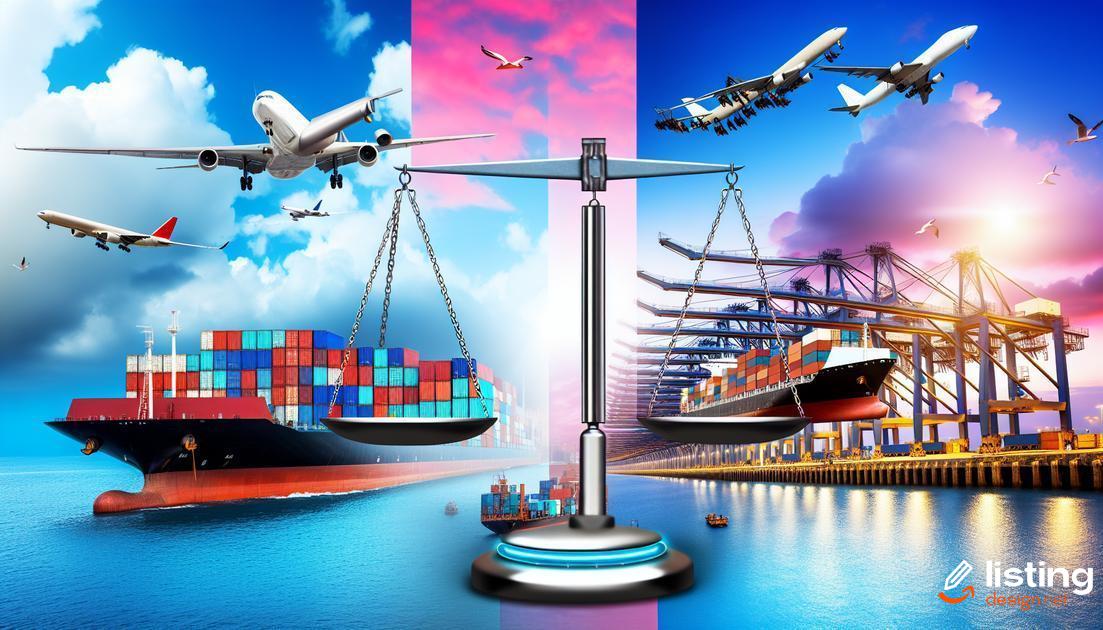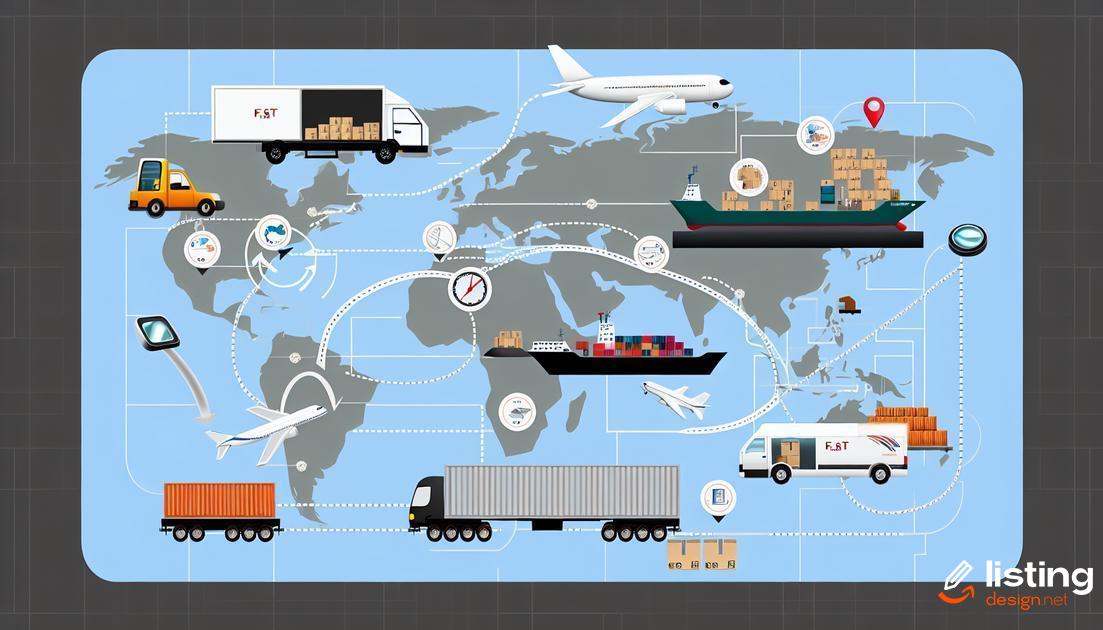Choosing the best shipping method from China to USA can be challenging. It’s crucial to understand the differences in shipping options, their costs, and transit times. This guide dives deep into various methods to help you make an informed decision, ensuring a smooth and efficient shipping process.
Table of Contents
Understanding Shipping Methods
When shipping goods from China to the USA, it is essential to understand the different shipping methods available. These methods vary significantly concerning speed, cost, and reliability. Selecting the right one depends on various factors such as the type of goods, budget, and delivery time constraints.
Air Freight is one of the most popular shipping methods due to its speed and reliability. It is ideal for high-value goods and shipments requiring urgent delivery. However, it can be more expensive compared to other options.
Sea Freight is a cost-effective alternative, especially for large and bulky shipments. Although it takes longer to reach the destination, it is a preferred option for businesses looking to save on shipping costs.
Besides these, Express Shipping options like DHL, UPS, and FedEx provide expedited delivery services. These are best suited for small parcels and samples that need to reach the USA quickly.
Understanding these shipping methods helps in making an informed decision, ensuring the goods arrive on time and within the budget.
Air Freight vs. Sea Freight

Air Freight offers a faster shipping solution compared to sea freight. This method is ideal for urgent shipments and high-value goods. Air freight typically takes 5-10 days for delivery, making it a popular choice for businesses that require quick shipping and fast turnaround times.
Sea Freight, on the other hand, is more cost-effective but slower. It is best suited for large, heavy, and non-urgent shipments. Sea freight can take anywhere from three weeks to several months, depending on the distance and shipping route. While it requires more time, it’s a more economical option for businesses looking to save on shipping costs.
An important consideration is the type of goods being shipped. Perishable items with short shelf lives might not fare well with sea freight due to the longer transit times. Conversely, non-perishable bulk goods benefit from the lower costs associated with sea freight.
A comparison between air and sea freight also includes the environmental impact. Air freight has a higher carbon footprint, which may be a concern for companies with sustainability goals. Sea freight, while slower, tends to have a smaller carbon footprint.
Choosing between air and sea freight depends largely on factors such as delivery urgency, budget, type of goods, and environmental considerations. Both methods have their pros and cons, and the decision should be tailored to the specific needs of the shipment.
Express Shipping Options
When it comes to sending packages swiftly, express shipping options are unmatched. This method often prioritizes speed, ensuring your goods arrive in the USA from China in the shortest time possible. Generally, express shipping is carried out by well-known carriers such as DHL, FedEx, and UPS. They offer door-to-door service, taking care of pick-up, handling, and delivery.
Benefits of Express Shipping
One of the major perks is the reduced transit time, often within 2 to 5 business days. This is especially crucial for businesses needing to restock quickly or meet urgent customer demands. Additionally, express services typically provide comprehensive tracking and prompt customer support, enhancing reliability and peace of mind.
Cost Factor
While express shipping is faster, it does come at a premium price. It’s essential to weigh the cost against the urgency of your shipment. For high-value, time-sensitive goods, the extra expense can be justified. Furthermore, express carriers often offer insurance options, adding an extra layer of security to your packages. This rapid and reliable method is ideal for ensuring your products reach their destination without delay.
Standard Shipping Methods

Standard shipping methods offer a balanced approach in terms of cost, speed, and reliability. They usually include services such as economy shipping, ground shipping, and standard parcel delivery. These methods are often utilized for non-urgent shipments and can be an ideal choice when sending goods that do not require rapid delivery.
Economy shipping is typically the most cost-effective option and may involve multiple carriers and longer transit times. Ground shipping, on the other hand, is carried out entirely via trucks and can be a good option for bulkier items. Standard parcel delivery falls somewhere in between, offering a reliable service at moderate speeds and costs.
When choosing a standard shipping method, it’s crucial to consider the weight and dimensions of your shipment. Heavier and larger packages often incur higher costs, so proper measurement and packaging can lead to savings.
Standard shipping methods usually come with tracking options. This allows you and your customers to monitor the package journey, providing a level of assurance. Be mindful of the carrier’s shipping policies and any included insurance to safeguard against potential loss or damage. Overall, understanding the nuances of standard shipping can lead to better decision-making and cost management.
Cost Comparison
When it comes to shipping methods from China to the USA, cost is a crucial factor to consider. The cost of shipping varies based on the method chosen, the weight of the shipment, and the speed of delivery required.
Air freight is generally more expensive than sea freight. However, it is much faster, making it ideal for high-value or time-sensitive goods. On the other hand, sea freight is more cost-effective for bulk shipments but takes significantly longer.
For businesses looking for a middle ground, express shipping options such as DHL, FedEx, and UPS offer relatively quick delivery times at a higher cost compared to standard shipping but less than air freight. It’s an excellent option for smaller packages that need to arrive quickly but don’t justify the cost of air freight.
Standard shipping methods typically involve sea freight and are the most economical for larger shipments that don’t have stringent time constraints. It’s a preferred choice for businesses that need to balance cost and delivery time.
By analyzing these factors, businesses can make informed decisions about which shipping method best suits their needs and budget.
Transit Time Considerations

When shipping goods from China to the USA, understanding transit time considerations is crucial for planning and delivering products efficiently. Transit times can vary greatly depending on the shipping method chosen. For example, air freight typically takes between 3 to 7 days, providing a faster option but often at a higher cost. Conversely, sea freight might take anywhere from 15 to 35 days but is generally more economical, especially for larger shipments.
Transit time is influenced by several factors, including the type of service (express or standard), customs clearance times, and potential delays due to weather or peak shipping seasons. In express shipping, prioritization of parcels can reduce transit time, but at a premium cost. Standard methods are less expensive but will include longer transit times.
Additionally, customs clearance plays a pivotal role. Efficient customs processes in both the origin and destination countries can drastically reduce overall transit time. Choosing a reliable carrier with proven experience in navigating these logistics can also mitigate unexpected delays and ensure more reliable delivery estimates.
Overall, matching your shipping needs with the appropriate method involves balancing cost, speed, and reliability to optimize your supply chain efficiently.
Customs Clearance Process
The customs clearance process is a crucial step in shipping goods from China to the USA. This process involves several stages, starting with the documentation review. Ensure that you have accurate and complete paperwork, including the commercial invoice, packing list, and bill of lading. Mistakes in these documents can lead to delays or even penalties.
Next, your goods must be classified under the appropriate Harmonized Tariff Schedule (HTS) code. This code determines the duties and taxes applicable to your shipment. Misclassification can result in incorrect tariffs and potential fines.
The inspection stage follows, where customs officers may physically check your goods. This inspection ensures that the shipment complies with all regulatory and safety standards. Make sure your packaging is easy to open and complies with all regulations to avoid issues during this stage.
After a successful inspection, you need to pay the required duties and taxes. It’s advisable to work with a customs broker who can handle these payments efficiently on your behalf. A broker can also assist with any issues that may arise during the clearance process.
The final stage is the delivery of your goods. Once cleared, your shipment is released for final delivery. Ensuring smooth customs clearance requires a thorough understanding of the process and careful preparation of all necessary documents.
Choosing a Reliable Carrier

When it comes to choosing a reliable carrier, several factors should be considered to ensure your shipment arrives safely and on time. Start by evaluating carriers’ reputations through reviews and feedback from other customers. A carrier with a solid track record will generally have high ratings and positive testimonials.
Next, consider the carrier’s network. Ensure they have a strong presence in both China and the USA, as this can significantly impact the efficiency of your shipping process. It’s also crucial to review the carrier’s shipping options, such as air freight, sea freight, and express services, to meet your specific needs.
Another important aspect is the carrier’s customer service. Effective communication can make a significant difference, especially when dealing with international shipping complexities. Choose a carrier that offers proactive updates and responsive support.
Insurance is a critical factor. Make sure the carrier provides comprehensive insurance coverage to protect your shipment against potential loss or damage. Additionally, pay attention to the carrier’s policies on customs clearance, as a reliable carrier will have a thorough understanding of the process and help navigate potential hurdles.
Lastly, while cost is an important factor, it shouldn’t be the only deciding criterion. Often, the cheapest option may not provide the same level of reliability and service quality. Balancing cost with reliability and services offered will help you make an informed decision.
Tips for Saving on Shipping Costs
When it comes to saving on shipping costs, there are several strategies that can help. First, consolidating shipments can reduce overall costs by minimizing the number of times you pay for shipping. Using standard shipping methods instead of express options can also save money, albeit with longer transit times.
Another effective tip is to negotiate rates with carriers. Many shipping companies offer discounts for larger volumes or long-term contracts. Additionally, consider exploring alternative carriers or less popular routes that may offer more competitive pricing.
Packaging optimization is another key area. Using the right size of packaging can reduce dimensional weight charges, while lightweight materials can lower the actual shipping weight. Bulk shipping and avoiding unnecessary packaging materials can further cut costs.
Finally, staying informed about current promotions and deals from carriers can lead to additional savings. Some companies offer seasonal discounts or special rates for new customers. Keeping an eye on these offers can provide significant cost reductions on shipping from China to the USA.
Tracking Your Shipment
![]()
Tracking your shipment is essential to ensure it arrives on time and without issues. Most courier services offer online tracking tools. Simply enter your tracking number on the courier’s website to get real-time updates.
How to Track Your Shipment
Upon dispatch, your shipping provider will give you a unique tracking number. This number is crucial for following your package’s journey. Make sure to keep it handy.
Visit the official website of your chosen shipping company. Look for the ‘Track’ or ‘Tracking’ section to enter your number. You’ll see updates on your package’s location, transit points, and estimated delivery time.
Some couriers also provide tracking updates via SMS or email. Enroll in these services to stay informed without needing to check the website manually.
Troubleshooting Common Tracking Issues
If your tracking number isn’t working, double-check it for errors. Sometimes, it may take a few hours or even a day for information to appear online after your package has been dispatched.
When to Contact Customer Support
If you still face issues or if tracking information hasn’t been updated for an extended period, contact the courier’s customer support. Provide them your tracking number and any other relevant details to get assistance.
By staying proactive and utilizing these tools, you can ensure a smooth shipping experience from China to the USA.
Handling Delays and Issues
Dealing with shipping delays and issues is an inevitable part of international trade. Properly managing these situations can help minimize their impact and keep your business running smoothly. Firstly, it’s essential to track your shipment regularly to stay informed about its status. Most carriers provide tracking tools that offer real-time updates.
If you encounter a delay, contact the carrier immediately to understand the cause and the expected resolution time. Clear communication can often lead to quicker solutions. It’s also helpful to have a contingency plan in place, such as stockpiling critical items, to buffer against unexpected delays.
Issues at customs can also cause delays. Ensure all documentation is complete and accurate to avoid hold-ups. If problems arise, a customs broker can often expedite the process by resolving paperwork issues and coordinating with customs officials.
Lastly, maintaining a good relationship with your carrier can be beneficial. They might offer insight into common issues on specific routes and suggested solutions. Regularly review your shipping performance data and identify patterns that can help you improve future shipping processes.
Choosing the Best Method for Your Needs

When choosing the best shipping method from China to the USA, several factors must be taken into account.
Cost vs. Speed
One of the first considerations is the balance between cost and speed. If your priority is to receive goods quickly, express shipping options like DHL, FedEx, or UPS are ideal but come at a higher price. On the other hand, standard shipping methods such as sea freight are more cost-effective but take longer to deliver.
Type of Goods
The nature of the items being shipped also plays a crucial role. For small and valuable items, air freight is often the best choice due to its speed and security. For larger, bulkier items, sea freight is generally more suitable, given its capacity to handle large volumes at a lower cost.
Customs Clearance
Another critical factor is the customs clearance process. A reliable carrier will simplify this process, ensuring that your shipment clears customs smoothly and avoiding delays and additional costs.
Reliability of the Carrier
Lastly, the reliability of the carrier cannot be overlooked. Research and choose a carrier with a proven track record for handling delays and issues effectively. User reviews and industry ratings can provide valuable insights into their performance.


